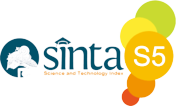EFEKTIFITAS PEMANFAATAN SERBUK BATU ALAM BERSILIKA, SILANE SEBAGAI PENGISI BAHAN ISOLASI RESIN EPOKSI DENGAN KOMPATIBILISER POLYETHYLENE UNTUK ISOLATOR LISTRIK
(1)
(2)
(*) Corresponding Author
Abstract
Insulation materials that commonly used in air insulation, which, is operated at high voltage, are the porcelain, glass, and polymer materials. One of the insulating polymer materials that are used is epoxy resin because it has several advantages compared to that. However, this insulation material has a degradation of the surface due to environmental and cause insulation coated with dirt and chemicals in the long time. This research was conducted on resin epoxy by comparison of MPDA, DGEBA, and filler (stone and silane) with a percentage value of 10%; 20%; 30%; 40% and 50%, sample size 120 x 50mm. Poly Ethylene is mixed as a compatibilzer of composite materials.
Research was done in laboratory according to standard IEC 587: 1984. In this study, the effect of variation in stoichiometry to the hydrophobic contact angle value, leakage current waveforms, and surface degradation caused by erosion and tracking processes and tracking time were analyzed. From the results of the research, it was obtained that the epoxy resin that was used in this research are categorized as partially wetted. The increase concentration of silane and silica stone as filler caused the increase in contact angle which meant the increase in surface insulation resistance, so that leakage currents flew on the surface not easily and slow down the aging or the degradation decreasing on the surface of insulating material. The concentration value of comapatibilizer material that had the optimal performance was 4%.
Keywords
Full Text:
PDFArticle Metrics
Abstract view : 458 timesPDF - 126 times
DOI: https://doi.org/10.26714/me.v13i1.5966
Refbacks
- There are currently no refbacks.
Copyright (c) 2020 MEDIA ELEKTRIKA
Editorial Office of Media Elektrika
Universitas Muhammadiyah Semarang FT-FMIPA Building, 7nd Floor. Phone: 085327178613 |

This work is licensed under a Creative Commons Attribution-ShareAlike 4.0 International License.


















